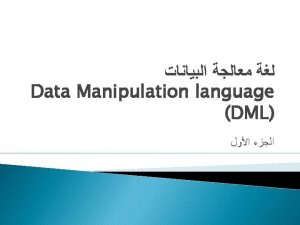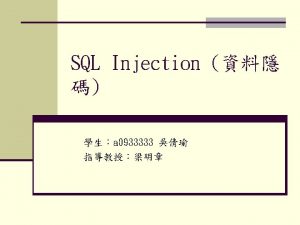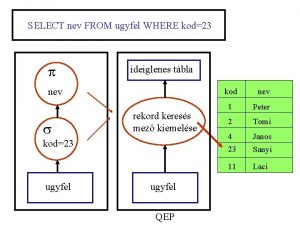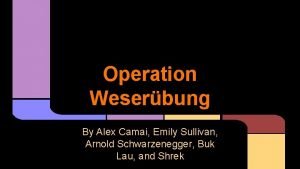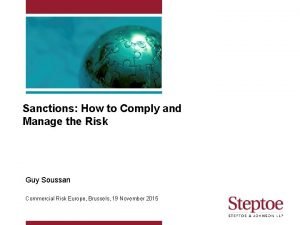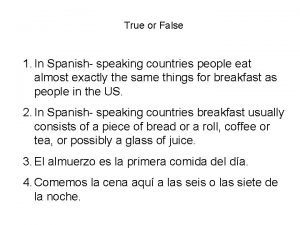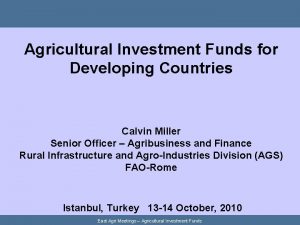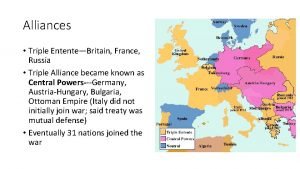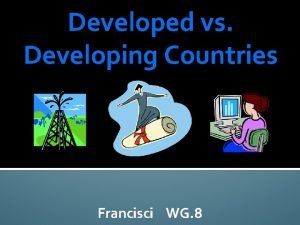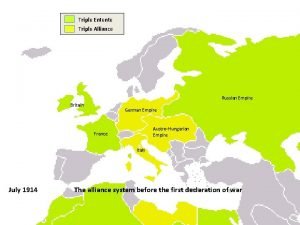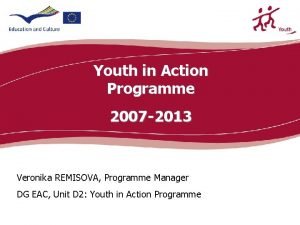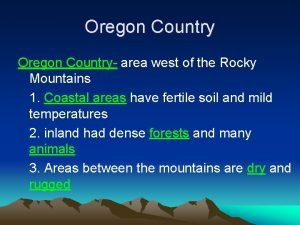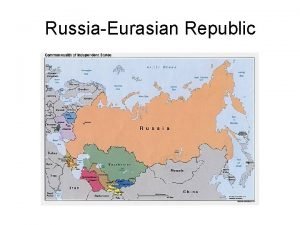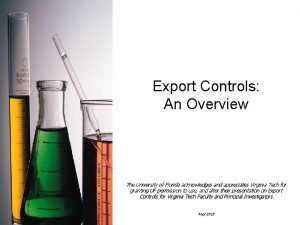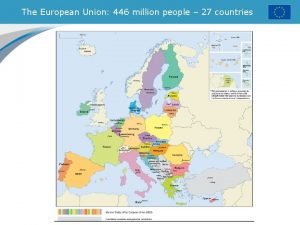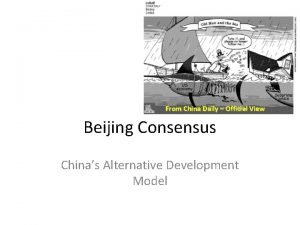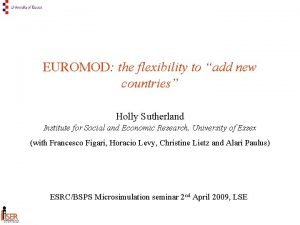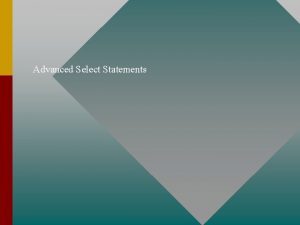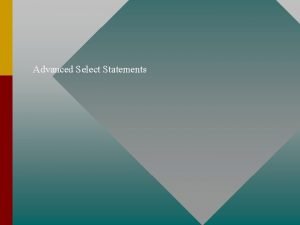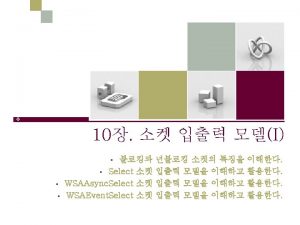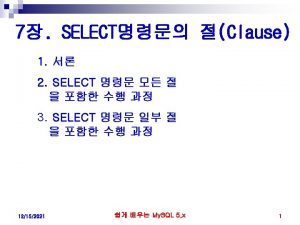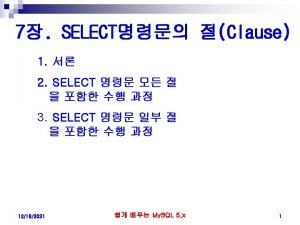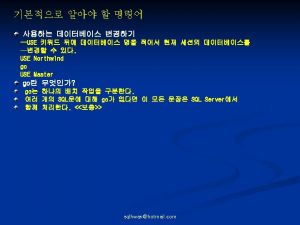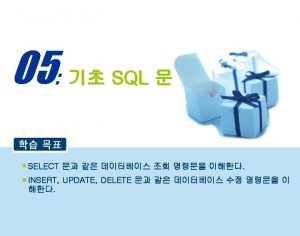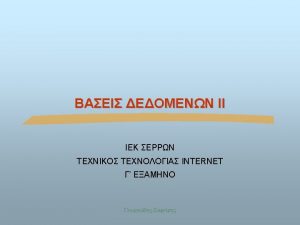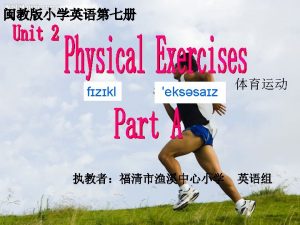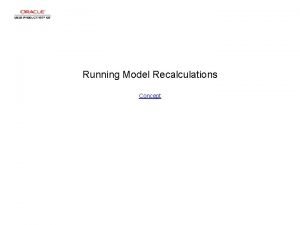1 Running EUROMOD 2 Running EUROMOD select countries










































- Slides: 42

1 Running EUROMOD

2 Running EUROMOD select countries select datasets select systems

3 Running EUROMOD status control display of run log and error log data and systems running run/ error log run dialog

4 Output files • Content manipulated in policy output_std_cc • Usually including: – All variables present in the input microdata file – Simulated variables (i. e. simulated taxes and benefits) – Standardized income lists – (optional) non-standard income lists – (optional) temporary variables – (optional) Tax unit identification info • Control level at which info is outputted (ex: individual, household etc. )

5 Statistics Presenter Tool • Output of EUROMOD= micro-data • Process using a statistical software package (ex. Stata) • Statistics Presenter Tool: quick way of generating some indicators • Computes a range of commonly used indicators and statistics: – poverty rates for the overall population and for selected groups and the Gini coefficient – distribution of household income, taxes and benefits by income group – demographic information on households by income group • Selection of default indicators with the possibility of new templates • 8 tables produced by the plug-in

6 Statistics presenter tool folder where your output file is stored

7 Statistics Presenter tool country and system on which statistics calculated 8 tables with ‘fixed’ statistics one sheet per output file

8 Implementing a simple reform • Where: – Simpleland • What: – make the child benefit more generous • How: – Open Simpleland – Add a new system where your reform will be implemented

9 Implementing a simple reform • How: – Open the child benefit policy – Make the changes in the new (reform) system – Run EUROMOD – Analyze results with the Statistics Presenter tool

10 Error handling produce an error

11 Error handling info on nature and location of the error

12 Error handling • • Output folder-error log file (text format) Same info as in the running dialog box Error logs contain time stamp of their creation Info about EUROMOD version, policy system where error occurred and dataset used

13 Documentation • Manuals – Euromod Terminology – Running Euromod and Basic Concepts – Euromod Functions all in built-in help • Country Reports (CR) (https: //www. euromod. ac. uk/using-euromod/country-reports) • EUROMOD Modelling Conventions (EMC) • Data Requirement Document (DRD)-1 per dataset • EM Working Paper series (https: //www. euromod. ac. uk/publications/type/EUROMOD%20 Working%20 Paper%20 Series)

14 Country report 1. Basic information – background information – brief description of all policies 2. Simulation of taxes and benefits in EUROMOD – scope and order of simulation – detailed information on simulated policies (incl. assumptions) 3. Data – general description and references to original data documentation – data adjustment, imputations and assumptions 4. Validation – policy validation – income distribution validation: poverty and inequality – “health warnings”

15 End of session

16 Exercise 1 • Running EUROMOD and producing summary statistics

17 EUROMOD functions and parameters

18 EUROMOD functions • Building blocks to implement policies – Parameters stored in XML and manipulated via the UI – Calculation in EUROMOD executable (C++ code) – ‘EUROMOD language’ • Standardised simulation language – Flexibility – Harmonisation – Parameterisation – Consistency (e. g. , errors handling) – Sufficiency (any country any policy) • Transparent and documented – In-built HELP – EMM_Functions manual (same info)

19 Structure of a function Function name/ type Parameter names Switch: on/off/ toggle Parameter values Parameters are either compulsory or optional

20 Policies • = block of functions that complete a ‘real’ policy simulation • can be manipulated independently – switch –affects all functions in the policy – same policy may be repeated by simple referencing – can be copied / moved • order of policies is called ‘spine’ • policy names end (usually) with the country acronym • each policy will have some explanation on what it is intended to simulate in the comment columns • policies can have any name • . . . but in practice we use some conventions • can be: – common to all countries (ex: defining uprating factors) – country specific (ex: means-tested child benefit for single parents)

21 Policies policy switch policy name policy description social insurance contribution policy made up of 3 functions

22 Manipulating functions and policies right-click on policy name to activate menu right-click on function/ parameter names to activate menu

23 Type of functions • System functions – functions used to define some general settings that are common across countries (ex: uprating, default values for datasets etc. ) • Policy functions – functions used to implement tax-benefit policies • Special functions – more advanced functions that perform more complicated tasks (loops, changing parameters at run-time etc. ) – not covered in this course

24 Policy functions Elig, Arith. Op

25 Function Elig • implements conditions • sets a variable (by default sel_s) to 0 or 1, based on the condition in elig_cond. Subsequent functions use this information via parameter who_must_be_elig

26 Function Arith. Op • Arithmetical calculator. The result of the parameter formula is stored as output variable

27 Parameters

28 Parameters • May be: – Common to several functions – Specific to one function • May be: – Compulsory (i. e. error generated if not used) – Optional – Which parameters are compulsory/ optional depends on the function • Order of parameters in a function is not important – (but order of functions in a policy is!!!!!!) • Manipulated via context menu – Only relevant parameters for the given function are shown • Drag & drop can be used

29 Parameters

30 Common “eligibility” parameters (1) – who_must_be_elig: function’s calculations are carried out if… – – – one_member (or one): one member of the assessment unit is eligible one_adult: one adult member of the assessment unit is eligible all_members (or all or taxunit): all members of the assessment unit are eligible all_adults: all adult members of the assessment unit are eligible nobody: calculations are carried out for each assessment unit (default) • “eligibility” is determined by the variable indicated by the parameter elig_var (by default sel_s) – 0: person is not eligible – 1: person is eligible

31 Common “eligibility” parameters (2)

32 Common “eligibility” parameters (3) nobody all_adults all one_adult who_must_be_elig one idhh sel_s dag idperson 1 11 80 1 1 1 0 0 1 1 12 60 0 1 1 13 40 0 1 1 0 0 1 2 21 80 1 1 1 0 1 1 2 22 6 0 1 1 3 31 80 1 1 1 4 41 40 0 0 1 4 42 40 0 0 1

33 Common output parameters – Output_var, output_add_var, result_var – func_Elig sel_s – Either output_var or output_add_var must be indicated

34 Common parameter TAX_UNIT • TAX_UNIT allows for the definition of the assessment unit a function refers to: – Individuals – Various definitions of family units – Household units • Compulsory for most policy functions

35 Common “limiting” parameters – Lowlim (lower limit) – Uplim (upper limit) – Threshold (threshold)

36 Linking functions

37 Interactions between functions (1) • The functions interact in three ways (+ replacement): – Condition: one function (usually function Elig) evaluates a condition and a subsequent function operates on the basis of the result of this evaluation

38 Interactions between functions (2) – Input: one function calculates a variable, which is used as an input by a subsequent function.

39 Interactions between functions (3) – Addition: one function calculates a part of a policy and a subsequent function calculates another part of the policy and therefore needs to add to the first part.

40 Result of a function • It is always assigned to the head of the assessment unit • For all other members of the unit and for those in not eligible units (defined by who_must_be_elig) : – output_var is set to zero. – output_add_var not changed or set to 0 if undefined before – result_var is set to zero.

41 Exercise 2 • Reforming Child Allowance in Estonia

42 End of session
 Once upon a time there lived a little country girl
Once upon a time there lived a little country girl Running running running
Running running running Select * from select
Select * from select Nemuadmin
Nemuadmin Select * from select
Select * from select Select * from select
Select * from select Lactose intolerance by country
Lactose intolerance by country What are some of the benefits and drawbacks of monsoons?
What are some of the benefits and drawbacks of monsoons? Countries in southeast asia
Countries in southeast asia Iron curtain political cartoon meaning
Iron curtain political cartoon meaning Weserbung
Weserbung Sanctioned countries
Sanctioned countries Country plural possessive
Country plural possessive Sunderland mfl
Sunderland mfl Google
Google Asia map
Asia map Los pasteles son muy _____ para la salud.
Los pasteles son muy _____ para la salud. How celebrate new year in different countries
How celebrate new year in different countries Countries that colonized mexico
Countries that colonized mexico Agricultural investment funds for developing countries
Agricultural investment funds for developing countries Triple entente countries
Triple entente countries Mauritius neighbouring countries
Mauritius neighbouring countries Who was in wwi
Who was in wwi What is a developing country definition
What is a developing country definition Countries that border mexico
Countries that border mexico Triple entente triple alliance
Triple entente triple alliance Few countries are as great as india
Few countries are as great as india Youth in action programme countries
Youth in action programme countries Which four countries claimed parts of the oregon country
Which four countries claimed parts of the oregon country 14thailand
14thailand Long skinny countries
Long skinny countries Primitive physical activities
Primitive physical activities Eurasian countries map
Eurasian countries map How did wwi begin?
How did wwi begin? English speaking countries quiz
English speaking countries quiz Sanctioned countries
Sanctioned countries Countries in southeast asia
Countries in southeast asia Warsaw pact countries
Warsaw pact countries Oecd countries
Oecd countries European union 28 countries
European union 28 countries Current british empire
Current british empire Http://hdr.undp.org/en/countries
Http://hdr.undp.org/en/countries Map suez canal
Map suez canal


